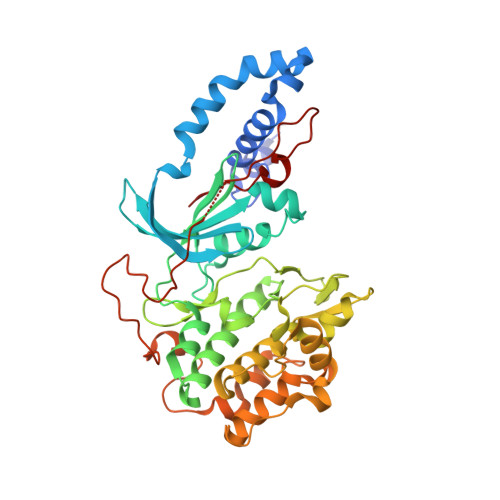Linking phenotype to kinase: identification of a novel benzoxaborole hinge-binding motif for kinase inhibition and development of high-potency rho kinase inhibitors.
Akama, T., Dong, C., Virtucio, C., Sullivan, D., Zhou, Y., Zhang, Y.K., Rock, F., Freund, Y., Liu, L., Bu, W., Wu, A., Fan, X.Q., Jarnagin, K.(2013) J Pharmacol Exp Ther 347: 615-625
- PubMed: 24049062
- DOI: https://doi.org/10.1124/jpet.113.207662
- Primary Citation of Related Structures:
4L6Q - PubMed Abstract:
Benzoxaboroles are a novel class of drug-like compounds that have been rich sources of novel inhibitors for various enzymes and of new drugs. While examining benzoxaborole activity in phenotypic screens, our attention was attracted by the (aminomethylphenoxy)benzoxaborole family, which potently inhibited Toll-like receptor-stimulated cytokine secretion from leukocytes. After considering their structure-activity relationships and the central role of kinases in leukocyte biology, we performed a kinome-wide screen to investigate the members of the (aminomethylphenoxy)benzoxaborole family. This technique identified Rho-activated kinase (ROCK) as a target. We showed competitive behavior, with respect to ATP, and then determined the ROCK2-drug cocrystal structure. The drug occupies the ATP site in which the oxaborole moiety provides hydrogen bond donors and acceptors to the hinge, and the aminomethyl group interacts with the magnesium/ATP-interacting aspartic acid common to protein kinases. The series exhibits excellent selectivity against most of the kinome, with greater than 15-fold selectivity against the next best member of the AGC protein kinase subfamily. Medicinal chemistry efforts with structure-based design resulted in a compound with a Ki of 170 nM. Cellular studies revealed strong enzyme inhibition rank correlation with suppression of intracellular phosphorylation of a ROCK substrate. The biochemical potencies of these compounds also translated to functional activity, causing smooth muscle relaxation in rat aorta and guinea pig trachea. The series exhibited oral availability and one member reduced rat blood pressure, consistent with ROCK's role in smooth muscle contraction. Thus, the benzoxaborole moiety represents a novel hinge-binding kinase scaffold that may have potential for therapeutic use.
Organizational Affiliation:
Anacor Pharmaceuticals, Inc., Palo Alto, California.















